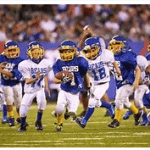

New research on 12 high school football players tracked for a season found that repeat head impacts affected the boys’ vision—even if those hits didn’t result in concussion.
“We found unique oculomotor [eye] response to head impacts, and realized that we still have much more to learn about brain response to trauma,” lead researcher Keisuke Kawata said in a university news release. He’s assistant professor at IU’s School of Public Health-Bloomington. It’s long been known that concussion can have severe and long-lasting effects on the brain, especially the still-developing teenage brain. “Concussions often result in disturbances in the ability to focus up close or the ability to move the eyes together, This occurs because of damage to the parts of the brain that are important in initiating these focusing activities ” explained Dr. Pomeranz, who directs neuro-ophthalmology at Northwell Health in Great Neck, N.Y.
But what about milder, “sub concussive” head hits? Using a high-tech device embedded in each of the 12 young player’s mouth guards, Kawata’s team recorded a collective total of more than 8,000 such hits occurring over the football season.
They also tested each boy’s eyes for changes in what vision specialists call “the near point of convergence.” That’s the ability to bring an object as close as possible to the eyes before the object appears to ‘double.’
The Indiana team found that the near point of convergence measurement increased by up to a third after frequent sub concussive head impacts.
But somehow the players’ eyes began to re-adjust, as well. Beginning at about mid-season, each player’s near point of convergence began to move back again towards its normal, pre-season level, the researchers found. This happened even though head hits continued to occur as the season wore on.
“Based on our previous studies, we thought that near point of convergence would be impaired throughout the entire season,” Kawata said. “Instead, near point of convergence was normalized to the baseline by the last quarter of the season, when players play their hardest to make it to the playoff stage.”
But while the effect on vision seemed to be temporary, there could still be implications for concussion
Dr. Mark Fromer is an ophthalmologist at Lenox Hill Hospital in New York City. He said the study offers important new insights.
“High school football players receive hundreds of head impact injuries per season,” he said, so “it is important to understand the damage these events can cause.”
Based on the Indiana research, it appears that the visual system does sustain damage from head impacts, but it “can continue to recover and adapt while it is still receiving repeated sub concussive events,” Fromer said.
The Indiana University researchers stressed that the changes in vision did seem temporary.
“Our study further lays the groundwork for understanding the usefulness—and limitations—of convergence as a clinical biomarker for understanding acute and chronic sub concussion,” said study co-author Steve Zonner, a sports medicine physician in Washington Township Medical Foundation.
The study was published Dec. 20 in the journal JAMA Ophthalmology.


